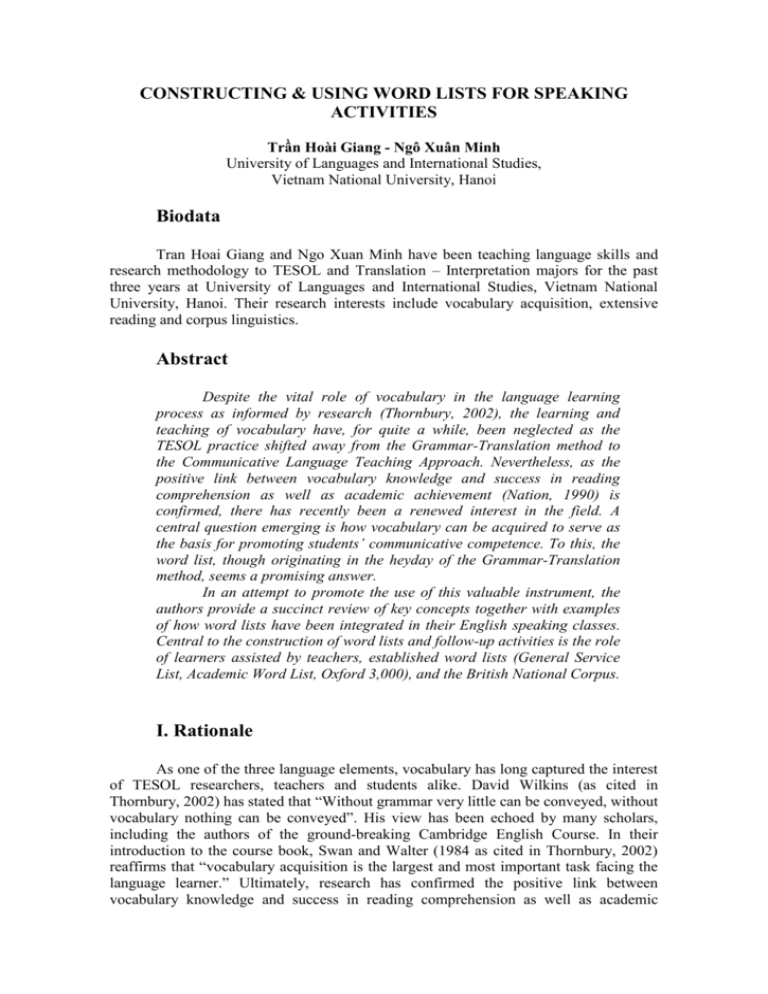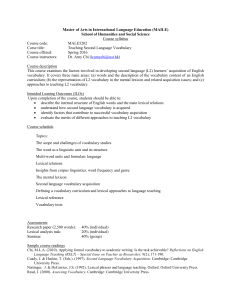EXPLICIT VOCABULARY INSTRUCTION WITH WORD LISTS
advertisement

CONSTRUCTING & USING WORD LISTS FOR SPEAKING ACTIVITIES Trần Hoài Giang - Ngô Xuân Minh University of Languages and International Studies, Vietnam National University, Hanoi Biodata Tran Hoai Giang and Ngo Xuan Minh have been teaching language skills and research methodology to TESOL and Translation – Interpretation majors for the past three years at University of Languages and International Studies, Vietnam National University, Hanoi. Their research interests include vocabulary acquisition, extensive reading and corpus linguistics. Abstract Despite the vital role of vocabulary in the language learning process as informed by research (Thornbury, 2002), the learning and teaching of vocabulary have, for quite a while, been neglected as the TESOL practice shifted away from the Grammar-Translation method to the Communicative Language Teaching Approach. Nevertheless, as the positive link between vocabulary knowledge and success in reading comprehension as well as academic achievement (Nation, 1990) is confirmed, there has recently been a renewed interest in the field. A central question emerging is how vocabulary can be acquired to serve as the basis for promoting students’ communicative competence. To this, the word list, though originating in the heyday of the Grammar-Translation method, seems a promising answer. In an attempt to promote the use of this valuable instrument, the authors provide a succinct review of key concepts together with examples of how word lists have been integrated in their English speaking classes. Central to the construction of word lists and follow-up activities is the role of learners assisted by teachers, established word lists (General Service List, Academic Word List, Oxford 3,000), and the British National Corpus. I. Rationale As one of the three language elements, vocabulary has long captured the interest of TESOL researchers, teachers and students alike. David Wilkins (as cited in Thornbury, 2002) has stated that “Without grammar very little can be conveyed, without vocabulary nothing can be conveyed”. His view has been echoed by many scholars, including the authors of the ground-breaking Cambridge English Course. In their introduction to the course book, Swan and Walter (1984 as cited in Thornbury, 2002) reaffirms that “vocabulary acquisition is the largest and most important task facing the language learner.” Ultimately, research has confirmed the positive link between vocabulary knowledge and success in reading comprehension as well as academic achievement (Chall, 1958; Klare, 1974-1975 and Saville-Troike, 1984 as cited in Nation, 1990). Despite its pivotal role, the learning and teaching of vocabulary at the University of Languages and International Studies (ULIS – VNU) have yet to receive adequate attention. Vocabulary instruction, according to Ngo (2009), is often a marginal part of four communicative skills with the task of vocabulary acquisition mostly left to students. There has so far been no official study into the results of this approach; nevertheless, from the authors’ observation in their own classes and exchanges with their colleagues, the lexical range and accuracy of second-year English majors do not seem to meet the prescribed standard, which is B2 in the Common European Framework. The problem is most noticeable in speaking classes where students often resort to simple, well-worn lexical items to achieve fluency rather than experiment with less common ones to communicate more complicated messages. Taking into account the above-mentioned points, the authors have decided to share their exploitation of the word list as a tool to boost students’ lexical performance in speaking activities. The tool itself dates back to the heyday of Grammar-Translation method, then fell out of favor with the advent of Communicative Language Approach, yet has earned a renewed interest in recent time (Tanaka, 2008) for its remarkable benefits as indicated in the later parts of this paper. II. Brief overview of related literature 2.1 What is a word? Simple as it may appear, the question has been recurrent in most remarkable studies and articles on vocabulary acquisition since the English language is rich in phrases like odds and ends, bits and pieces which are often interpreted as one semantic unit. This view is reflected in Oxford Advanced Learner’s Dictionary (8th Edition, 2010) where word is defined as “a single unit of language which means something and can be spoken or written”. As far as the writers are concerned, the concept of word should be comprehended in this light as this will encourage the acquisition of chunks of language, resulting in learners’ enhanced fluency (Thornbury, 1998). 2.2 What does word knowledge involves? Besides the definition, another critical question in need of a definite answer is what knowing a word entails. As one of the pioneering attempts, Richards (1976 as cited in Read, 2000, p.25) has enumerated a list of aspects of a word a learner should know: Knowing a word means knowing the degree of probability of encountering that word in speech or print. For many words we also know the sort of words most likely to be found associated with the word. Knowing a word implies knowing the limitations on the use of the word according to variations of function and situation. Knowing a word means knowing the syntactic behavior associated with the word. Knowing a word entails the knowledge of the underlying form of a word and the derivations that can be made from it. Knowing a word entails knowledge of the network of associations between that word and other words in the language. Knowing a word means knowing the semantic value of a word. Knowing a word means knowing many of the different meanings associated with a word. (Richards, 1976 as cited in Read, 2000) His approach has been taken further by Nation (1990, p.31) who introduces an analytical table, adding other components and the distinction between receptive and productive knowledge. Form Spoken form Written form Position Grammatical Patterns Collocations Function Frequency Appropriateness Meaning Concept Associations R P R P What does the word sound like? How is the word pronounced? What does the word look like? How is the word written and spelled? R In what patterns does the word occur? P In what patterns must we use the word? R What words or types of words can be expected before or after the word? P What words or types of words must be used with this word? R How common is the word? P How often should the word be used? R Where would we expect to meet the word? P Where can this word be used? R P R P What does the word mean? What word should be used to express this meaning? What other words does this word make us think of? What other words could we use instead of this one? Table 1. Knowing a word (Nation, 1990) (R=receptive, P=productive) The table represents what Nation (1990) terms as the learning burden faced by learners in their lexical acquisition. Additionally, according to the authors, it informs teachers’ design of tools and activities to share and alleviate the learner’s burden, reminding them to go beyond the surface layers of word knowledge. 2.3 How can lexical knowledge be acquired? According to vocabulary experts, vocabulary is acquired in two ways, namely intentional vocabulary learning (also known as deliberate/explicit/conscious vocabulary learning) and incidental vocabulary learning (also called vocabulary learning in context) (Schmitt, 2000). The first one focuses directly on lexical items, thus giving the greatest chance for their acquisition. Nevertheless, it is “time-consuming and laborious” to develop an adequately sized lexicon for communication. In the second approach, vocabulary can be learnt when one is communicating in the language, which means a double benefit for the time spent. Nonetheless, it is much slower than intentional learning, which means one has to read extensively to come across a certain word. What is more, there are certain prerequisites to be met before one can learn vocabulary incidentally especially from reading authentic texts. The “vocabulary size threshold” for this purpose is between 3,000 to 5,000 word families in Nation and Waring (1997) or from 7,000 to 10,000 words in Fox (1987, p.309). Recently, due to the misinterpretation of the communicative approach, “learning vocabulary in context is often seen as opposed to intentional learning” (Nation, 2001, p.232) whereas in actual fact, they complement one another, for each seems more suited for particular types or aspects of vocabulary. For instance, Schmitt (2000, p.122-3) adds that reliable intuition of collocation is derived from numerous exposures through incidental learning while meaning is “amenable to conscious learning”. In other words, explicit vocabulary learning and teaching still play a crucial role, and thus should not be marginalized. 2.4 What is a word list? According to Richards and Schmidt (2010), a word list is “a list of the basic and most important words in a language or in a register of a language, generally intended for use as a basis for language teaching or for the preparation of teaching materials.” Regarding its construction, the word list is often informed by “frequency counts or by other measures of the importance of words”. Typical examples of word lists by this definition are the General Service List by West (1953 as cited in Nation, 1990) and the Academic Word List by Coxhead (2000). Nevertheless, the term can be simply understood as a list of key words of a particular English lesson, which is the view taken by the authors of this paper. Traditionally, a word list tends to include the head words and their L1 equivalents; nonetheless, different elements may be added depending on the intentions of its creator (the teacher or student). 2.5 Advantages of using word lists As previously mentioned, there has been renewed enthusiasm about word lists thanks to the array of benefits on offer. Recent researches by Nation (1995) and Meara (1995) have vindicated the word list as a very efficient means of developing L2 lexical knowledge. Dutton (2006) further clarifies the advantages of using word lists for both students and teachers alike. Regarding the former subjects, word lists provide the “tangible learning direction” whereas for the latter these can serve as the basis to develop teaching materials. By the same token, Thornbury (2002) highlights the time and effort saving advantage of word lists since a fair amount of lexical knowledge can be obtained in a relatively short period of time. 2.6 Possible limitations Nevertheless, the word list, like every tool, has its own limitations. Nakata (2008) refers to the “list effect” or the tendency of learners to memorize by associating the word with its position in the list, leading to the retrieval problem when encountering the word outside the list. Another issue worthy of consideration is the decontextualized vocabulary learning as the words are studied as separate units, totally isolated form their authentic context, resulting in the possible vocabulary misuse by students despite their knowledge of the words’ meaning. Last but far from least, the word list may fail to include “chunks of language such as collocations, phrases, or expressions” which are essential for communicative fluency (McCarten, 2007). Acknowledging all the problems of the traditional word list, the authors of the paper have conceived an adapted word list model in order to better facilitate the teaching and learning of vocabulary. III. Word lists in our classes Rather than prescribed by teachers, word lists in our speaking classes are basically prepared and exploited by students since learners controlling how they learn words score 50% better in retention tests than when studying random word lists set for them (Atkinson, 1972 as cited in McCarthy, 1990, p.130). However, as in most learning activities, teachers’ guidance is needed. In groups of three or four, students prepare and host an activity to help their classmates learn and practice the key vocabulary items of each unit in the course book. In short, the following steps are followed by students: - Read through the assigned unit in the course book and select key lexical items related to the topic. - Make a list of these words, including the transcription, part of speech, meaning, and example for each item. (The list should not exceed 30 items) (The word list can also be displayed in a variety of visually stimulating ways such as word trees, bubble networks, matrices, etc.) - Design an activity to present the new words and help their classmates use them in speaking. - Submit to the teacher the material package and consult with him/her at least 7 days before facilitating the activity in class. Make adjustments based on the teacher’s feedback. Students are advised to consider the frequency and range of words. Richards and Schmidt (2010) defined frequency as “the number of occurrences of a linguistic item in a text or corpus” (p.232) and range as “a measure of the number of texts or sample in which a linguistic item occurs” (p.479). In the case of word list construction, whether words with higher frequency and wider range or the opposite should be prioritized depends largely on the aim of the course and each lesson. An exam preparation course for standardized academic tests like the IELTS would mean the inclusion of academic words with lower frequency while a much more communicative course would emphasize more frequent, general words. In our case, priority is given to words relevant to the topic and of lower frequency (belonging to Nation’s University Word List (1990), Coxhead’s Academic Word List (2000), and the 3,000, 5,000 or 10,000 levels in West’s General Service List (1954)), regarding students’ expected levels (B1-B2). All of these resources can be downloaded for free from the Internet or accessed indirectly through the Web Vocabprofile developed from the Range program by Heatley and Nation (1994). As knowing a word involves being able to produce the word in context (Nation, 1990), students are required to provide examples for most head words. Nevertheless, to minimize negative mother tongue interference, students are encouraged to consult authentic texts. A reliable and accessible resource is the British National Corpus (BNC), which offers for free numerous examples from authentic sources. Based on these, students will produce their original examples which can illustrate the appropriate usage of the head words. Interface of the British National Corpus - a 100 million word collection of samples of written and spoken language from a wide range of sources Once the decision has been made on what words to be listed, attention should also be drawn to how they are presented. A list can look as conventional as a table, or as creative as a mind map. The traditional table layout with various columns featuring different aspects of the words seems rather economical and convenient. No. Spelling & part of speech 1. Villain (n) 2. Intriguing (adj) ɪnˈtriːgɪŋ 3. Hilarious (adj) hɪˈleəriəs extremely funny and causing a lot of laughter rɪˈbeliəs If someone is rebellious, they are difficult to control and do not behave in the way they are expected to 4. Pronunciation Rebellious (adj) ˈvɪlən Meaning Examples a bad person who harms other people or breaks the law to interest someone a lot, especially by being strange, unusual or mysterious As he looked a complete villain, no one trusted him. After the intriguing conversation with the President, I couldn’t wait to read his biography. His ability to bring hilarious fun made him the soul of every party. The mother was shocked when the child answered in a high-pitched rebellious voice. A student-generated word list with corpus-adapted examples Conclusion In effects, the available teaching materials offer students a handy source of vocabulary items, and word lists are one way for teachers to explicitly draw students’ attention to vocabulary learning, foster their autonomy and encourage the use of newly acquired lexical items in speaking. With the help of established word lists like the GSL, Oxford 3000, and AWL as well as the BNC and the Web Vocabprofile, students can make better informed decisions regarding the selection of words and presentation of the list as well as the design of in-class activities. REFERENCES Carter, R. (2001). Vocabulary. In Carter, R. & Nunan, D. (Eds.), The Cambridge Guide to Teaching English to Speakers of Other Languages (pp. 42 – 47). Cambridge: Cambridge University Press. Cobb,T. (n.d.) Web Vocabprofile. Accessed 1st April 2012 from http://www.lextutor.ca/vp/eng Coxhead, A. (2000). A new academic word list. TESOL Quarterly, 34, 213 – 218. Retrieved 30th March 2012 http://www.jstor.org/stable/3587951. Dutton, M. (2006). Word lists tagging for teachers: investigating the correlation of the general servicethlist and academic word list to IELTS task 2 writing. Paper presented at 19 Annual EA Education Conference. Retrieved 28th March 2012 http://www.englishaustralia.com.au/index.cgi?E=hcatfuncs&PT=sl&X=getdoc &Lev1=pub_c07_07&Lev2=c06_dutto Foley, A. (n.d.) thUsing academic word lists in the communicative classroom. Retrieved 27 March 2012 http://www.englishaustralia.com.au/index.cgi?E=hcatfuncs&PT=sl&X=getdoc &Lev1=pub_c09_07&Lev2=c08_foley2 Hornby, A.S. (2010). Oxford Advanced Learner’s Dictionary Eighth Edition. Hong Kong: Oxford University Press. McCarten, J. (2007). Teaching Vocabulary – Lessons from the Corpus – Lessons for the Classroom. Retrieved 29th March 2012 http://www.cambridge.org/us/esl/touchstone/images/pdf/McCarten_booklet.pd f McCarthy, M. ((1990). Vocabulary. Hongkong: Oxford UniversitystPress. Moore, D.W. (n.d.). Why Vocabulary Instruction Matters. Retrieved 31 March 2012 http://www.ngsp.net/Portals/0/Downloads/HBNETDownloads/Edge_Mono_M oore2.pdf Nakata, T. (2008). English vocabulary learning with word lists, word cards and computers: implications from coginitive psychologythresearch for optimal spaced learning. ReCALL 20 (1): 3-20. Retrieved 27 March 2012 http://journals.cambridge.org/download.php?file=%2FREC%2FREC20_01%2 FS0958344008000219a.pdf&code=97e46af5e154f55cdb323feb4fadd1e3 Nation, I.S.P. (1990). Teaching and learning vocabulary. Boston: Heinle & Heinle Publishers. Ngo, X.M. (2009). Vocabulary levels and learning strategies of first-year English majors. Unpublished B.A. thesis, University of Languages and International Studies, VNU. Read, J. (2000). Assessing Vocabulary. Cambridge: Cambridge University Press. Richards, J.C. & Schmidt, R. (2010). Longman Dictionary of Language Teaching and Applied Linguistics (Fourth Edition). Malaysia: Longman Ltd. The British National Corpus (version 3) (BNC XML Edition) (2007). Oxford University Computing Services on behalf of the BNC Consortium. URL: http://www.natcorp.ox.ac.uk/ Thornbury, S. (1998). The lexical approach: a journey without maps. Retrieved 29th March 2012 http://www.thornburyscott.com/assets/Lexical%20approach.pdf Thornbury, S. (2002). How to teach vocabulary. Malaysia: Longman Group Ltd. Vanbenthuysen, R. (n.d.). Explicit vocabulary instruction: using a word list to focus attention. Retrieved 28th March 2012 http://www.u-bunkyo.ac.jp/center/library/image/fsell2002_89-96.pdf







